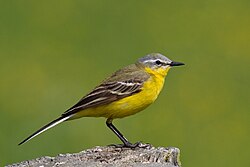Top Qs
Timeline
Chat
Perspective
Western yellow wagtail
Species of bird From Wikipedia, the free encyclopedia
Remove ads
The western yellow wagtail (Motacilla flava) is a small passerine bird in the wagtail family Motacillidae, which also includes the pipits and longclaws. This species breeds in much of temperate Europe and Asia. Most populations are migratory, moving south to tropical Africa and southern Asia for the winter; the small population breeding in Egypt is however resident there.
It is a slender 15–16 cm long bird, with the characteristic long, constantly wagging tail of its genus. It is the shortest tailed of the European wagtails. The breeding adult male is basically olive above and yellow below. In other plumages, particularly in juveniles, the yellow may be diluted to whitish. The heads of breeding males come in a variety of colours and patterns depending on subspecies. The call is a high-pitched jeet.[2] This insectivorous bird inhabits open country near water, such as wet meadows. It nests in tussocks, laying 4–8 speckled eggs.
Remove ads
Taxonomy
Summarize
Perspective
The western yellow wagtail was formally described in 1758 by the Swedish naturalist Carl Linnaeus in the tenth edition of his Systema Naturae under its current binomial name Motacilla flava.[3] In 1555 the Swiss naturalist Conrad Gessner had used the identical Latin name Motacilla Flava when describing this species in his book, Historia animalium.[4] Linnaeus specified the type locality as Europe but this is now restricted to southern Sweden.[5] The genus name Motacilla is the Latin name for the wagtail; although actually a diminutive of motare, "to move about", from medieval times it led to the misunderstanding of cilla as "tail". The specific flava is Latin for golden-yellow.[6]
This species' systematics and phylogeny is confusing. Dozens of subspecies have been described at one time or another, and some 15-20 are currently considered valid depending on which author reviews them. In addition, the citrine wagtail (M. citreola) forms a cryptic species complex with this bird;[7][page needed] both taxa as conventionally delimited are paraphyletic in respect to each other. The populations of the Beringian region are sometimes separated as eastern yellow wagtail (M. tschutschensis).
Subspecies
The ten recognised subspecies are listed below.[8] Plumage colours refer to males except when noted; females are often hard to impossible to identify to subspecies.[9] Vernacular names of the European subspecies follow Svensson (1992).[9]
The nominate blue-headed wagtail and yellow wagtail form a narrow hybrid zone in northern France. Birds from this zone vary in appearance, but one type, which resembles nominate blue-headed wagtail (except that the blue tones to the head are paler and more mauve and the white of the head is more extensive, particularly on the throat, ear-coverts, and supercilium) is colloquially referred to as Channel wagtail. A hybrid zone between M. f. flava and M. f. feldegg in Romania and nearby, sometimes distinguished as separate subspecies "M. f. dombrowskii" or "M. f. superciliaris", is also variable, but often like M. f. feldegg except with a white supercilium, rather than a solid black head.[9][10]
Remove ads
In culture
In the Pyramid Texts of Old Kingdom Egypt, the yellow wagtail was considered a representation of Atum himself and might have been the first inspiration for the Bennu bird, which, in turn, is the supposed inspiration for the phoenix of Greek mythology.[11]
The yellow wagtail is the subject of a poem, Motacilla flava flavissima, in Polly Atkin's 2021 poetry collection, Much With Body.[12]
Gallery
- Eggs, Collection Museum Wiesbaden
- Immature blue-headed wagtail (M. f. flava)
- male M. f. lutea, Matetsi Safari Area, Zimbabwe
- Cuculus canorus canorus egg in a clutch of Motacilla flava eggs - MHNT
References
Sources
External links
Wikiwand - on
Seamless Wikipedia browsing. On steroids.
Remove ads
















